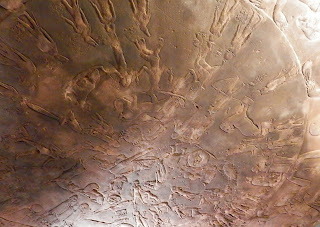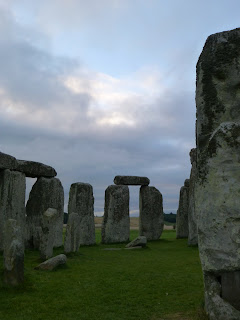Bleeding Yew of St. Brynach's
It was late afternoon when we arrived at the church of St. Brynach, north of St. David's, Wales. The site is known for several unique features, including the lane of old yew trees in the churchyard, which are on the Great Yews of Wales Tree Trail. (Find your tree trail maps here.) The yew tree is found in most graveyards and churchyards in the UK, and in many cases it's not clear which came first--the yew trees or the churches. The yews are hundreds of years old, and in pagan tales were said to mark sites that were sacred to the Earth Goddess, and so may have predated many of the buildings.
Yews grow very slowly, are evergreen, and are said to symbolize rebirth. Yews have also been linked with the World Tree or the Tree of Life; avenues for connecting upper and lower worlds. In this churchyard it feels like that may be so. The change in energy is stunning. You are immediately hushed into a state of reverence and quiet reflection. One of the descriptions called the churchyard, trees and old graves "deliciously" spooky, and it is.
One of the yew trees is famous for its blood-like red sap, and is called the "bleeding yew." Different stories as to the reason it "bleeds" depends on your worldview. Scientists have no definitive explanation. Pagans say it bleeds because it is connected with the Earth Mother (representing menstrual flow). Christian tales attribute it to the blood of Christ. And there is one tale of a hanging of an innocent man, and another proclaiming that the tree will bleed until a Welshman is king.
I loved reading the tale of 6th century St. Brynach, who after living on Carn Ingli in communion with angels, was divinely guided to find the site for a church, being told that his sign would be the white sow, sacred symbol of the Goddess Ceridwen. He then walked to Nevern near the stream where he found the sow, and hence the church was built there. What better way to site a church in this area of Wales known, in previous generations, as Menevia or Mynyw, which can be translated to "way of the moon" or "lunar paradise."
The foundation of the church dates to 540 C.E., while the current building is 12th century Norman construction. The church also boasts some fascinating stone monuments, the Maglocunus stone and the Vitialanus stone, rare because they display inscriptions in both 5th century Ogham and Latin, which assisted in deciphering the Ogham script. One of them may mark the gravesite of Vortigern, a 5th century leader and warlord, an early king of Powys.
In addition, a beautifully ornate 10th or 11th century Celtic cross stands in the churchyard, and inside the church there is another unique knotted cross in stone. The equal armed cross within a circle, the "sun cross," is said to represent not only the Christian cross, but the sun and the four directions or seasons, and to me it joins the masculine linearity and the feminine circle/cycle of life/earth in balance. The four arms are said to represent nature, self, knowledge and God. To me the circle represents sun, earth and moon, all of life linked: as above, so below.
The veil was certainly thin in this remarkable place. Would that the stones and trees could speak of the history! Especially of the clashes over religion, as Christianity overtook the native paganism. For a few moments I quietly stood under the yew trees, hands on the trees, willing them to gift me with their perspective, with what they'd seen and heard. There was sorrowful, deep, intuitive, dark sort of understanding present. And, for balance, two dragonflies played in the setting sun amongst the trees--living in the moment, in that flash of brilliance and joy for what is, right here, right now. They allowed me to photograph their trails of light in a few photographs, and I was grateful.
Yews grow very slowly, are evergreen, and are said to symbolize rebirth. Yews have also been linked with the World Tree or the Tree of Life; avenues for connecting upper and lower worlds. In this churchyard it feels like that may be so. The change in energy is stunning. You are immediately hushed into a state of reverence and quiet reflection. One of the descriptions called the churchyard, trees and old graves "deliciously" spooky, and it is.
 |
| Yew Trees at St. Brynach's |
I loved reading the tale of 6th century St. Brynach, who after living on Carn Ingli in communion with angels, was divinely guided to find the site for a church, being told that his sign would be the white sow, sacred symbol of the Goddess Ceridwen. He then walked to Nevern near the stream where he found the sow, and hence the church was built there. What better way to site a church in this area of Wales known, in previous generations, as Menevia or Mynyw, which can be translated to "way of the moon" or "lunar paradise."
The foundation of the church dates to 540 C.E., while the current building is 12th century Norman construction. The church also boasts some fascinating stone monuments, the Maglocunus stone and the Vitialanus stone, rare because they display inscriptions in both 5th century Ogham and Latin, which assisted in deciphering the Ogham script. One of them may mark the gravesite of Vortigern, a 5th century leader and warlord, an early king of Powys.
 |
| Nevern Cross |
In addition, a beautifully ornate 10th or 11th century Celtic cross stands in the churchyard, and inside the church there is another unique knotted cross in stone. The equal armed cross within a circle, the "sun cross," is said to represent not only the Christian cross, but the sun and the four directions or seasons, and to me it joins the masculine linearity and the feminine circle/cycle of life/earth in balance. The four arms are said to represent nature, self, knowledge and God. To me the circle represents sun, earth and moon, all of life linked: as above, so below.
The veil was certainly thin in this remarkable place. Would that the stones and trees could speak of the history! Especially of the clashes over religion, as Christianity overtook the native paganism. For a few moments I quietly stood under the yew trees, hands on the trees, willing them to gift me with their perspective, with what they'd seen and heard. There was sorrowful, deep, intuitive, dark sort of understanding present. And, for balance, two dragonflies played in the setting sun amongst the trees--living in the moment, in that flash of brilliance and joy for what is, right here, right now. They allowed me to photograph their trails of light in a few photographs, and I was grateful.
 |
| Dragonfly Dance |


Comments